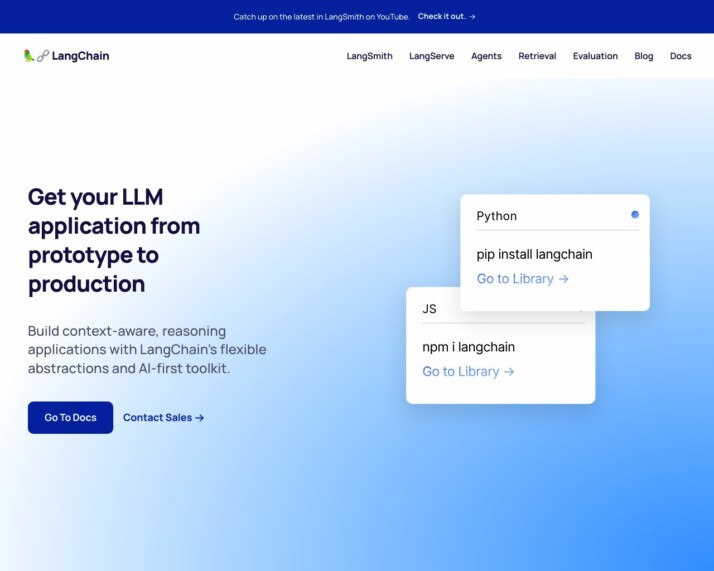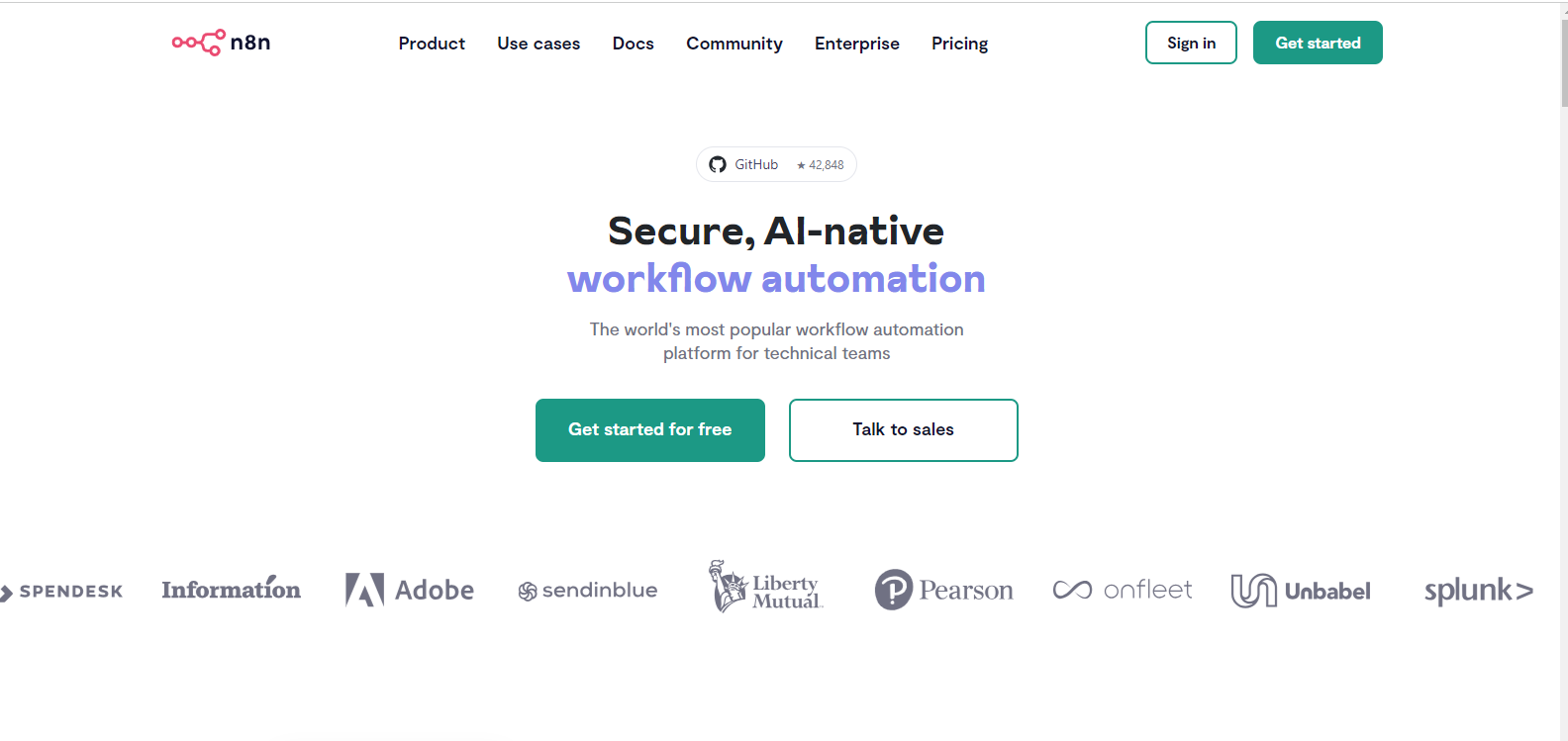LangChain vs. n8n: AI-Driven vs. General Automation
AI and automation technologies have transformed the landscape of software development and business operations. LangChain vs. n8n, and SmythOS each offer unique approaches to harnessing these powerful tools. LangChain provides a robust framework for building sophisticated AI applications with large language models.
n8n excels in general-purpose workflow automation with its visual interface and extensive integrations. SmythOS combines the best of both worlds, offering AI-powered automation with unparalleled ease of use and deployment flexibility. This comparison explores the strengths and limitations of each platform, helping developers, business leaders, and AI enthusiasts make informed decisions about which solution best fits their needs for creating intelligent, efficient, and scalable applications.
LangChain Overview
LangChain empowers developers to create sophisticated applications powered by large language models (LLMs). This open-source framework simplifies the entire LLM application lifecycle, from development to deployment. LangChain’s modular approach allows developers to build, test, and deploy LLM applications efficiently.


LangChain offers a comprehensive suite of tools for LLM integration. Its core components include LangGraph for creating stateful, multi-actor applications, and LangSmith for debugging, testing, and monitoring. LangChain’s Expression Language (LCEL) enables declarative chaining of components, optimizing performance through parallel execution and streaming support.
LangChain empowers developers to create sophisticated applications powered by large language models (LLMs). This open-source framework simplifies the entire LLM application lifecycle…
Developers benefit from LangChain’s extensive library of pre-built components, including chat models, prompt templates, and document loaders. The platform supports various LLM tasks, from simple text generation to complex retrieval-augmented generation (RAG). LangChain’s flexibility allows seamless integration with popular LLM providers and third-party tools.
While LangChain excels in providing a robust framework for LLM applications, it requires a certain level of technical expertise. The platform’s focus on modularity and customization may present a steeper learning curve for beginners compared to more visual, no-code solutions. Additionally, LangChain’s open-source nature means that users are responsible for hosting and maintaining their own infrastructure.
LangChain’s strength lies in its adaptability and extensive ecosystem. The platform’s active community contributes to a growing collection of tools and integrations, expanding its capabilities. For developers seeking fine-grained control over their LLM applications, LangChain offers unparalleled flexibility and power.
n8n Overview
n8n empowers users to create powerful workflow automations without extensive coding knowledge. This fair-code platform combines the flexibility of open-source software with commercial use restrictions, offering a unique approach to workflow automation.


n8n’s intuitive drag-and-drop interface allows users to connect various applications and automate tasks effortlessly. The platform supports a wide range of integrations, including popular tools like Slack, Google Sheets, and Typeform. This extensive integration capability, combined with conditional logic and custom coding options, provides unparalleled flexibility for diverse automation needs.
n8n empowers users to create powerful workflow automations without extensive coding knowledge. This fair-code platform combines the flexibility of open-source software with commercial use restrictions…
One of n8n’s standout features is its fair-code model, which balances open-source availability with commercial use restrictions. This approach fosters a vibrant community of users and developers who contribute to the platform’s growth and provide support through forums and discussions. The result is a constantly evolving ecosystem that benefits both individual users and businesses.
While n8n excels in many areas, it may not be the ideal choice for users seeking a fully open-source solution or those requiring extensive enterprise-level support. Additionally, the platform’s learning curve might be steeper for users with no prior experience in workflow automation or basic programming concepts.
n8n’s scalability makes it suitable for both small businesses and large enterprises. The platform’s ability to handle complex workflows with custom nodes and integrations ensures it can adapt to growing business needs. However, users should consider their specific requirements and technical expertise when evaluating n8n against other automation platforms.
Feature Comparison
LangChain and n8n offer contrasting approaches to workflow automation and AI integration. LangChain focuses on building sophisticated AI applications powered by large language models (LLMs), while n8n provides a more general-purpose workflow automation platform.
LangChain excels in AI agent development, offering tools like LangGraph for creating stateful, multi-actor applications with LLMs. It provides robust support for memory and context management, enabling AI agents to maintain coherent interactions over time. LangChain’s emphasis on explainability and transparency, facilitated by LangSmith, gives developers deep insights into their AI applications’ behavior.
n8n, on the other hand, lacks dedicated AI agent capabilities but shines in its visual workflow builder and extensive third-party integrations. While n8n supports connecting to AI services, it does not offer the same level of AI-specific tools and components as LangChain. n8n’s strength lies in its ability to automate tasks across various applications and services, making it more suitable for general workflow automation rather than specialized AI development.
In terms of security, both platforms offer OAuth support, but LangChain provides more advanced features for constrained alignment and data encryption. n8n’s fair-code model may offer more flexibility for some users, but it also comes with commercial use restrictions that LangChain does not impose.
LangChain’s deployment options are more AI-centric, allowing developers to deploy their applications as APIs, chatbots, or integrate them with existing LLM platforms. n8n focuses on workflow deployment, which may be more limiting for users seeking to create standalone AI applications.
While both platforms offer valuable tools for automation and integration, LangChain’s specialized AI capabilities make it a more powerful choice for developers focused on building advanced AI agents and applications.
Feature Comparison Table
| LangChain | n8n | SmythOS | |
|---|---|---|---|
| CORE FEATURES | |||
| AI Agents | ✅ | ❌ | ✅ |
| Visual Builder | ❌ | ✅ | ✅ |
| No-Code Options | ❌ | ❌ | ✅ |
| Memory & Context | ✅ | ❌ | ✅ |
| Autonomous Agents | ✅ | ❌ | ✅ |
| Multi-Agent Collaboration | ✅ | ❌ | ✅ |
| Human-AI Interaction | ✅ | ❌ | ✅ |
| Agent Work Scheduler | ❌ | ✅ | ✅ |
| SECURITY | |||
| Constrained Alignment | ❌ | ❌ | ✅ |
| IP Control | ❌ | ❌ | ✅ |
| COMPONENTS | |||
| Foundation AIs | ✅ | ❌ | ✅ |
| Huggingface AIs | ✅ | ❌ | ✅ |
| Zapier APIs | ❌ | ✅ | ✅ |
| Classifiers | ✅ | ❌ | ✅ |
| Data Lakes | ❌ | ❌ | ✅ |
| DEPLOYMENT OPTIONS (EMBODIMENTS) | |||
| Deploy as Webhook | ❌ | ✅ | ✅ |
| Staging Domains | ❌ | ❌ | ✅ |
| Production Domains | ❌ | ❌ | ✅ |
| Deploy as Scheduled Agent | ❌ | ✅ | ✅ |
| Deploy as GPT | ✅ | ❌ | ✅ |
| DATA LAKE SUPPORT | |||
| Hosted Vector Database | ❌ | ❌ | ✅ |
| Sitemap Crawler | ❌ | ❌ | ✅ |
| YouTube Transcript Crawler | ❌ | ❌ | ✅ |
| URL Crawler | ❌ | ❌ | ✅ |
| Word File Support | ❌ | ✅ | ✅ |
Best Alternative to LangChain and n8n
SmythOS emerges as the premier alternative to LangChain and n8n, offering a comprehensive AI automation platform that combines the best of both worlds. We’ve designed SmythOS to address the limitations of these competitors while providing a more intuitive, powerful, and versatile solution for AI agent development and workflow automation.
Unlike LangChain’s code-heavy approach and n8n’s limited AI capabilities, SmythOS features a user-friendly drag-and-drop interface that simplifies the creation of sophisticated AI agents. Our visual builder empowers users of all skill levels to design complex workflows without extensive programming knowledge, making AI development accessible to a broader audience.
SmythOS features a user-friendly drag-and-drop interface that simplifies the creation of sophisticated AI agents… making AI development accessible to a broader audience.
SmythOS excels in its extensive feature set, surpassing both LangChain and n8n in critical areas. We offer robust support for memory and context management, enabling AI agents to maintain coherent interactions over time. Our platform also provides advanced multi-agent collaboration capabilities, allowing teams of AI agents to work together on complex tasks—a feature notably absent in n8n.
When it comes to deployment options, SmythOS outshines the competition. We provide a wide range of deployment methods, including APIs, webhooks, scheduled agents, and even integration with popular AI platforms like GPT. This versatility ensures that our users can seamlessly integrate AI agents into their existing systems and workflows, regardless of their specific requirements.
Perhaps most importantly, SmythOS offers unlimited use cases, breaking free from the constraints of LangChain’s AI-centric focus and n8n’s general workflow automation. Our platform supports a vast array of AI models, data sources, and integrations, enabling users to create tailored solutions for virtually any business need. From chatbots and content generation to complex data analysis and decision-making systems, SmythOS empowers users to harness the full potential of AI across diverse applications.
Conclusion
LangChain and n8n offer powerful tools for developers and businesses seeking to harness the potential of AI and automation. LangChain excels in AI-specific tasks, providing a robust framework for building sophisticated LLM-powered applications. Its modular approach and extensive ecosystem make it a top choice for developers deeply invested in AI development. n8n, on the other hand, shines in general workflow automation, offering an intuitive visual interface and a wide array of integrations that appeal to both technical and non-technical users.
While both platforms have their strengths, SmythOS emerges as the superior choice for those seeking a comprehensive, user-friendly solution that combines the best of both worlds. SmythOS offers an unparalleled blend of AI capabilities and workflow automation, wrapped in an intuitive drag-and-drop interface. Our platform’s ability to create and deploy AI agents across various environments, coupled with our extensive integration ecosystem of over 300,000 connections, sets a new standard in the industry.
SmythOS stands out with its “Create Once, Deploy Anywhere” philosophy, allowing users to build sophisticated AI agents that can be seamlessly integrated into multiple platforms. This versatility, combined with our robust security features, scalability, and support for diverse AI models, makes SmythOS the ideal choice for businesses of all sizes looking to leverage AI and automation effectively.
We invite you to experience the future of AI-powered automation with SmythOS. Explore our diverse range of AI-powered agent templates to jumpstart your journey, or dive into our comprehensive documentation to discover the full potential of our platform. Ready to revolutionize your workflow? Create a free SmythOS account today and join the AI workforce 3.0 revolution.
Last updated:
Disclaimer: The information presented in this article is for general informational purposes only and is provided as is. While we strive to keep the content up-to-date and accurate, we make no representations or warranties of any kind, express or implied, about the completeness, accuracy, reliability, suitability, or availability of the information contained in this article.
Any reliance you place on such information is strictly at your own risk. We reserve the right to make additions, deletions, or modifications to the contents of this article at any time without prior notice.
In no event will we be liable for any loss or damage including without limitation, indirect or consequential loss or damage, or any loss or damage whatsoever arising from loss of data, profits, or any other loss not specified herein arising out of, or in connection with, the use of this article.
Despite our best efforts, this article may contain oversights, errors, or omissions. If you notice any inaccuracies or have concerns about the content, please report them through our content feedback form. Your input helps us maintain the quality and reliability of our information.
